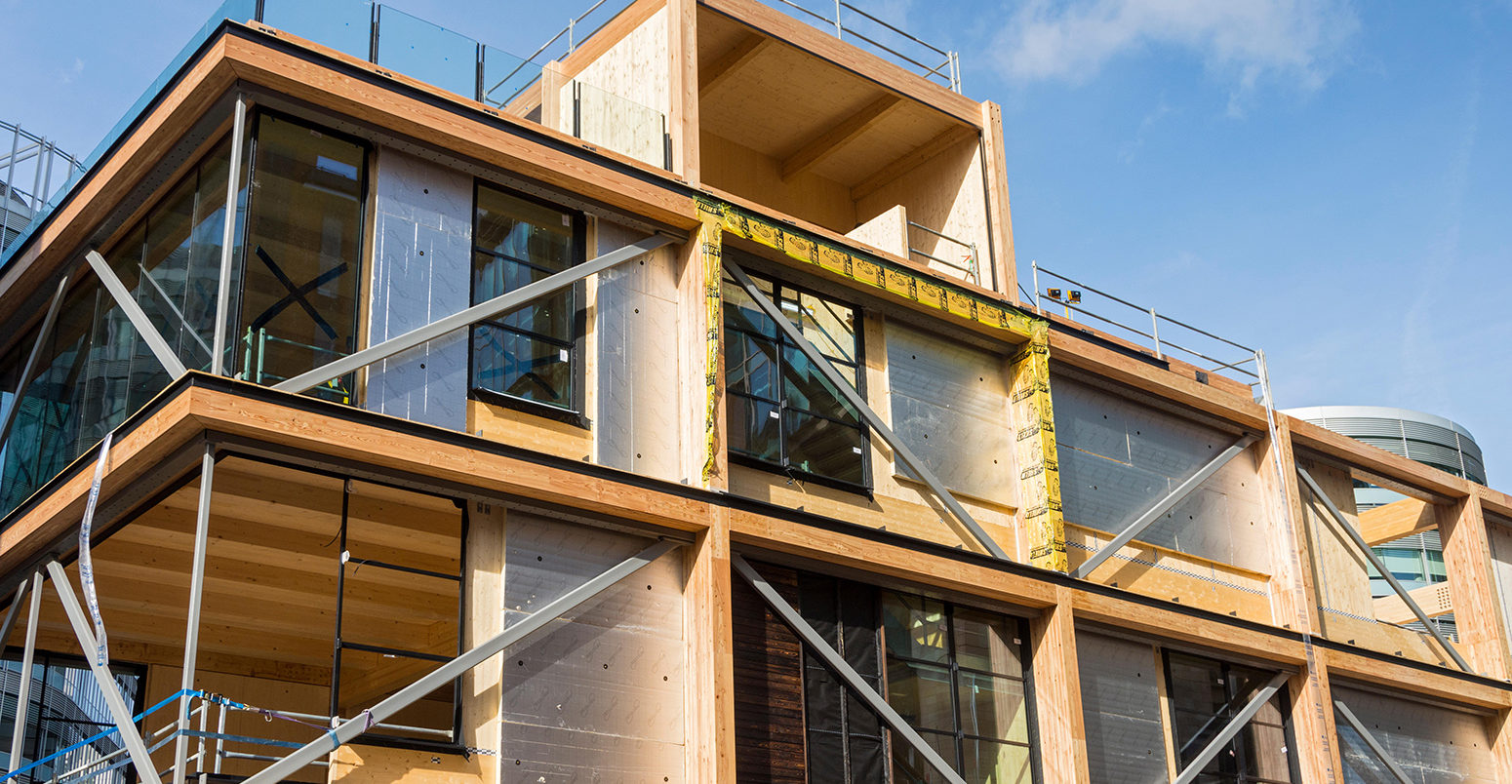
CCC: UK should ‘move away’ from large-scale biomass burning
Simon Evans
11.15.18The UK should not give support to any new large-scale biomass power plants unless they include carbon capture and storage (CCS), according to the Committee on Climate Change (CCC).
Biomass has a potentially important role to play in meeting UK climate targets, but needs to be used in a different way in future, the CCC says in a report published today. Existing biomass power subsidies – which mostly expire in 2027 – should be allowed to run their course, adds the government’s official climate advisory body.
The UK should also phase out biofuel use in cars and vans in the 2030s, focusing on aviation fuels instead. Support for direct biomass heating should be significantly restricted, the CCC adds.
The UK has to be “very careful” to use biomass only where there are few alternatives, the CCC chair Lord Deben tells Carbon Brief. “You don’t burn it in boilers; you use it to make aeroplane fuel.”
In the longer term, this means biomass use should focus on locking away CO2, the CCC says. This includes wood-framed buildings and – conditional on much tougher regulations for lifecycle greenhouse gas emissions – generating fuel, power or heat from biomass with CCS (BECCS).
Biomass today
The UK’s use of biomass for energy has significantly increased over the past decade, as the chart below shows. Biomass now supplies around 7% of the UK’s primary energy needs, the CCC says.
Home-grown supplies of plant biomass have expanded, including straw and energy crops (red wedge at the bottom of the chart). Anaerobic digestion has also grown (dark grey wedge in the middle of the chart). This involves wastes being used to produce gas in the absence of oxygen.
But much of the increase has been met with imported wood pellets (dark blue wedge, “imported plant biomass”), where supplies have more than tripled.
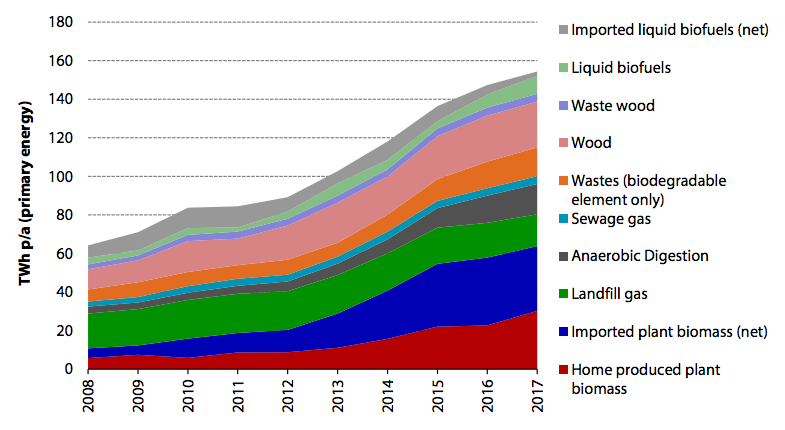
Bioenergy supply in the UK between 2008 and 2017, terawatt hours per year of primary energy (TWh/yr). Plant biomass includes straw, energy crops, short rotation forestry and wood pellets. Source: Figure 1.4 in Biomass in a low-carbon economy, CCC 2018, based on Department for Business, Energy and Industrial Strategy figures.
Most of these imported wood pellets are burnt at Drax in Yorkshire – formerly Europe’s largest coal plant – which has converted four of its six units to use biomass instead. These imports account for around a quarter of UK bioenergy, as well as the large majority of public and press attention on the topic.
The increase in UK bioenergy use has been driven by subsidies for renewable electricity and heat generation, including the Renewables Obligation, Contracts for Difference and the Renewable Heat Incentive. There has also been a rising obligation to blend biofuels into petrol and diesel.
The CCC’s new report says many of these current uses of biomass should eventually stop.
New direction
The reason for this change of direction is that biomass supplies are finite in UK and global terms. In future, this means only the most beneficial uses of biomass should be prioritised, the CCC says.
The schematic below sets out a hierarchy of biomass best use in various sectors of the economy (the rows in the graphic) and along a timeline to 2050 (reading from left to right).
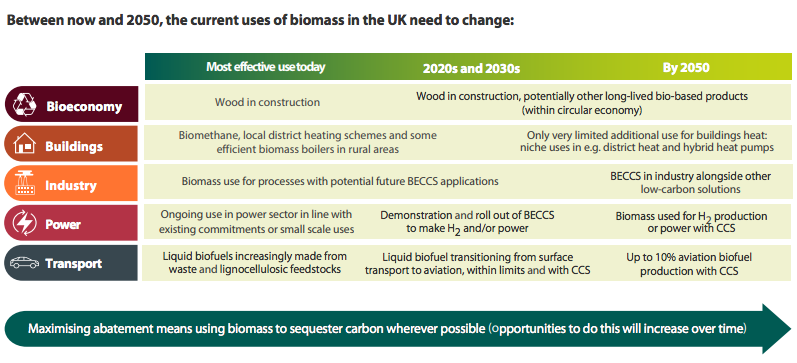
Hierarchy of best use for sustainable biomass resources between now and 2050. Source: Figure 2 in Biomass in a low-carbon economy, CCC 2018.
In simple terms, the hierarchy gives highest priority to options that do not burn biomass, such that the carbon it contains can be locked away for years. This includes wood in construction, where the CCC says there is significant potential to expand on the 15-28% of new homes built using timber frame construction.
The next-highest priority goes to BECCS, where biomass is burned or converted and the resulting CO2 is captured and locked away. This will only be possible with efforts to demonstrate and roll out the technology starting in the 2020s, the CCC says. It is also conditional on bringing in tighter rules on biomass sourcing, discussed in the next section below.
At present, BECCS is largely untested, though its component technologies are individually well-understood. In May, Drax announced plans to pilot BECCS starting with lab studies. A demonstration phase capturing one tonne of CO2 per day is set to be operating within weeks.
BECCS is often assumed to relate only to electricity generation, but it can also apply to biomass used for hydrogen, industrial use, heat or biofuel production.
At the bottom of the CCC’s hierarchy are existing uses of biomass to generate heat, electricity or biofuels without CCS. Ultimately, these should be phased out, it says.
Most strikingly, this means that no new subsidies should go to burning biomass on a large-scale to generate electricity, the CCC says. Existing subsidy contracts for Drax and a smaller site at Lynemouth in Northumberland expire in 2027 and should be honoured.
Government policy “appears to be in line” with this, the CCC says, as it has placed new restrictions on the emissions savings that newly subsidised biomass power projects would have to meet.
It has also moved such projects into “pot 1” of the CfD scheme, where they would be unlikely to outcompete cheaper bids from onshore wind and solar, should auctions ever go ahead.
The CCC also says that biofuels should no longer be blended into fuel for cars and vans from the 2030s and that government should end most support for biomass burned for heat, except in niche applications, such as remote or hard to hear homes.
(The government is currently consulting on restricting its Renewable Heat Incentive to homes outside urban areas without access to the gas grid.)
Aviation fuel derived from biomass should used to meet up to 10% of demand as part of a package of measures to bring the sector in line with UK climate goals, the CCC says. This includes limiting passenger demand growth and combining aviation biofuel production with CCS.
Tighter rules
The CCC’s recommendations are conditional on tightening the rules that govern biomass sourcing.
This is because the climate impacts of using biomass to displace fossil fuels have been subject to heated debate over many years. Critics argue that biomass burning can be worse for the climate than coal, whereas supporters say the greenhouse gas savings are significant.
The CCC’s report clearly and carefully sets out the arguments that frame this debate. Ultimately, it concludes that biomass can be sustainable, but that too often it is unsustainable. It says that current rules around biomass sourcing are too lax and suggests ways they should be tightened.
The report says:
The evidence suggests that sustainable low-carbon bioenergy is possible, but that this can only be achieved in certain circumstances, if certain practices and criteria are applied.
The amount of carbon stored in soils and forests is at the heart of this debate. Crucially, carbon stock changes are not currently counted towards eligibility for government biomass subsidies.
To address these shortcomings, the CCC sets out the following proposals:
“As a general rule, unsustainable or high-risk feedstocks (eg feedstocks from primary, high-carbon, highly biodiverse or slow-growing forests) should be regulated out and best practice encouraged (eg use of organic wastes and genuine agricultural or forestry residues, certain perennial crops grown on marginal land)…
“BEIS and DfT [the Department for Business, Energy and Industrial Strategy, and the Department for Transport] should address the current weakness in the criteria on preserving carbon stocks in existing forests by requiring that any long-term changes in forest carbon stock at landscape scale are included in the calculation of the climate impacts of bioenergy systems.”
As noted above, BEIS has already tightened the emissions threshold for newly subsidised biomass schemes. Note that this threshold is calculated without accounting for carbon stock changes.
This significantly lower threshold would nevertheless rule out the use of imported wood pellets for new projects, as the chart below shows. It does not apply to existing projects, such as Drax.
A spokesperson for Drax tells Carbon Brief that wood pellets could meet this tighter threshold: “If sourced from the UK as suggested by the CCC for the future…We’re continually looking at how we can further reduce our emissions, including those from our supply chain.”
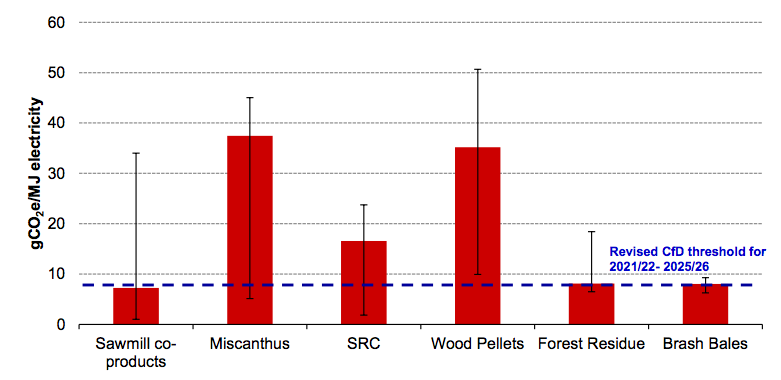
Reported lifecycle emissions, by biomass fuel type, under the Renewables Obligation for electricity generation (grammes of CO2 equivalent per megajoule of electricity). The bars show weighted average reported emissions for each category and the error bars show the highest and lowest values reported. Source: Figure 2.6 of Biomass in a low-carbon economy, CCC 2018.
Asked whether the government would implement the even tighter rules the CCC is recommending, including on accounting for carbon stock changes, Lord Deben tells Carbon Brief:
“We should be pressing the government very hard to make these changes because they are crucial to the future of biomass…We don’t want it undermined by the fact that people can point to unsustainable practices.”
Long-term role
The CCC says that biomass could have a potentially significant long-term role in helping to meet UK climate goals. Again, this is conditional on tighter sustainability rules and its hierarchy of use.
Lord Deben tells Carbon Brief:
“Sustainable biomass is both possible and necessary. Unsustainable biomass is both widespread and unacceptable. The truth is that as the world moves on towards the demands of Paris, biomass is going to play an important part.
“There are some things for which it seems the only basis for deep reductions. That means we have to be very careful not to use biomass in areas where there are alternatives…You don’t burn it in boilers, you use it to make aeroplane fuel.”
Provided these conditions are met, the CCC says 5-15% of the UK’s primary energy needs could be supplied by biomass. In addition, 20-65m tonnes of CO2 (MtCO2) could be removed from the atmosphere each year using BECCS, it says.
These numbers are similar to those in the CCC’s 2011 review of bioenergy. This said around 10% of energy could come from biomass and included similar levels of emissions removals.
In its 2018 report, the CCC sets out its view on the potential for sustainable biomass supply in global and UK-specific scenarios for the future of land use. [The CCC has published a parallel report on land use and climate, also covered by Carbon Brief.]
These global scenarios are shown in the chart below (red columns) alongside potential demands for biomass (blue) drawn from integrated assessment model (IAM) pathways to global climate goals. The CCC’s “high” biomass scenario is well below the level in many IAMs, it notes.
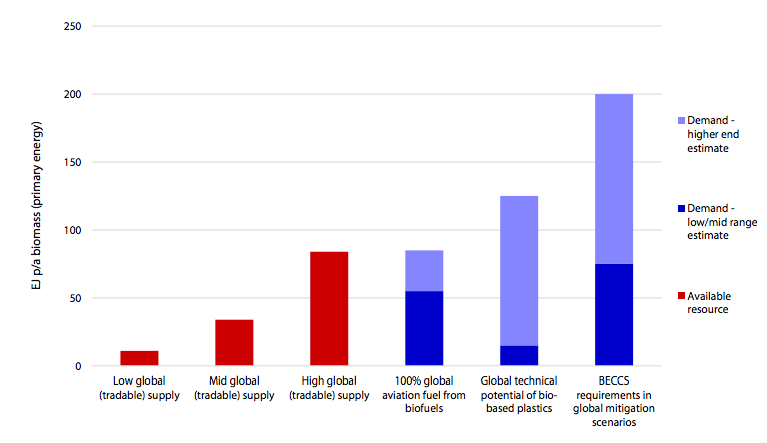
Potential global supply and demand for biomass by end-use application in 2050 (exajoules per year of primary energy). See the report for the lengthy note that accompanies this chart. Source: Figure 5.1 of of Biomass in a low-carbon economy, CCC 2018.
The chart above emphasises the fact that there is not enough biomass to meet all possible end uses, meaning the way it is used must be prioritised.
Domestic supply
The CCC then looks at how much biomass could be produced sustainably in the UK and what share of global supply could fairly be imported to complement domestic production.
This leads to five scenarios of future UK biomass supply in 2050. From today’s 140 terawatt hours per year (TWh/yr, far right column on the chart, below), these range from below 100TWh in the “poor global governance” pathway through to over 500TWh in the “UK BECCS hub” scenario.
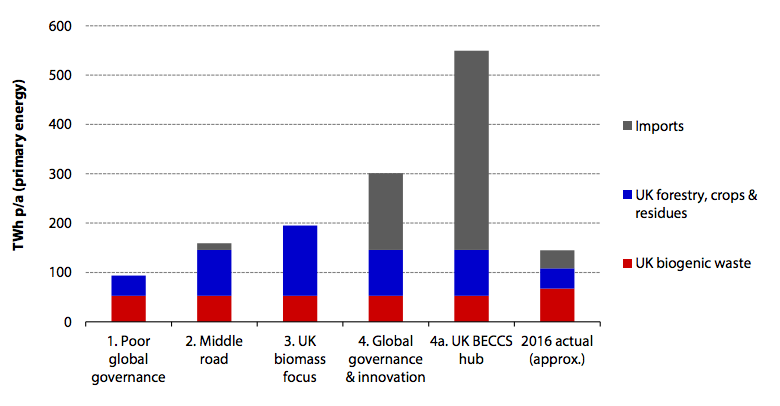
UK biomass supply scenarios in 2050 (TWh/year of primary energy). Source: Figure 4.7 of Biomass in a low-carbon economy, CCC 2018.
The level of biomass availability depends on the success of global sustainability governance, as well as UK and international choices on land use, diets and other factors.
Notably, however, the CCC says there is significant potential to raise UK biomass output and that this could be enough to meet demand, without any imports.
-
CCC: UK should ‘move away’ from large-scale biomass burning
-
UK should ‘move away’ from large-scale biomass burning, says CCC

